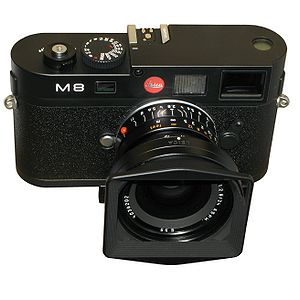Leica M8
 |
|
| Overview | |
|---|---|
| Type | Digital rangefinder camera |
| Lens | |
| Lens | Leica M-mount |
| Sensor/Medium | |
| Sensor | 18 x 27 mm inducing a 1.33 crop factor |
| Maximum resolution | 10.3 effective megapixels (3936 x 2630 pixels) |
| ASA/ISO range | 160 to 2500 |
| Focusing | |
| Focus modes | Manual |
| Exposure/Metering | |
| Exposure modes | Manual, aperture priority auto exposure |
| Exposure metering | TTL, center weighted averaging |
| Flash | |
| Flash | Fixed hot shoe |
| Shutter | |
| Shutter | Focal plane, metal curtains, vertical travel |
| Shutter speed range | 8s to 1/8000 |
| Viewfinder | |
| Viewfinder |
Reverse Galilean (x0.68) with automatic or manual selection of parallax corrected framelines, additional color LCD display: 2.5", 230,000 pixels |
| General | |
| Battery | Lithium Ion |
| Dimensions | 139 x 80 x 37 mm |
| Weight | 545 g without battery |
| Made in | Germany |
Reverse Galilean (x0.68) with automatic or manual selection of parallax corrected framelines,
The Leica M8 is the first digital camera in the rangefinder M series introduced by Leica Camera AG on 14 September 2006. It uses an APS-H 10.3-megapixel Kodak KAF-10500 CCD image sensor.
As of 15 July 2011, the most recent firmware version is 2.014.
The M8 body is slightly thicker than the classic MP and M7 (approximately ~14% thicker). It is an all-metal body made of a high-strength magnesium alloy. The top and base plates are cut from brass billets, before receiving a black or silver chrome finish.
The M8 supports all existing Leica M-mount lenses, however some older models might not offer all the functions due to mismatching cams. All lenses are multiplied by a 1.33x crop factor, hence a 28mm lens will act approximately like a 35mm when mounted to the M8. Because the sensor lacks an infrared filter, an IR-cut filter in front of the lens is recommended. In addition, Leica chooses to omit the Anti-Alias filter, citing the reason for higher resolution power of the lens. However, the moiré artifacts can occur in scenes with closely spaced geometric patterns, such as fabric or mesh, distant buildings, balcony railings, corrugated roofing etc.
The M8 uses modern metal-blade focal-plane shutter. It can fire flash synchronization at 1/250 second X-sync and has a top shutter speed of 1/8000 sec. The flash system used in the M8 is M-TTL.
The camera uses a 6-bit coding system that identifies the lens in use to the electronics built into M8 body. The code is included on all current Leica lenses. To prevent excessive vignetting due to closer lens mount than in a DSLR and thus higher light rays angle on the sensor periphery, offset micro-lenses are used on the CCD. The 6-bit code on lenses gives information about optic vignetting characteristics, permitting software adjustment. The M8 uses Adobe DNG as its raw data format and the raw converter Capture One LE (included with the camera).
The Leica M8 suffered from some controversy on its release due to image quality problems reported by some users, especially an extremely high sensitivity to infrared light, which made black colors appear purple. Leica has since released a statement saying that it will send two free special UV/IR screw-on photographic filters to all future M8 purchasers, and upon request for all current M8 users. Users experiencing other image quality problems can apply to return their M8 for repair.
...
Wikipedia
